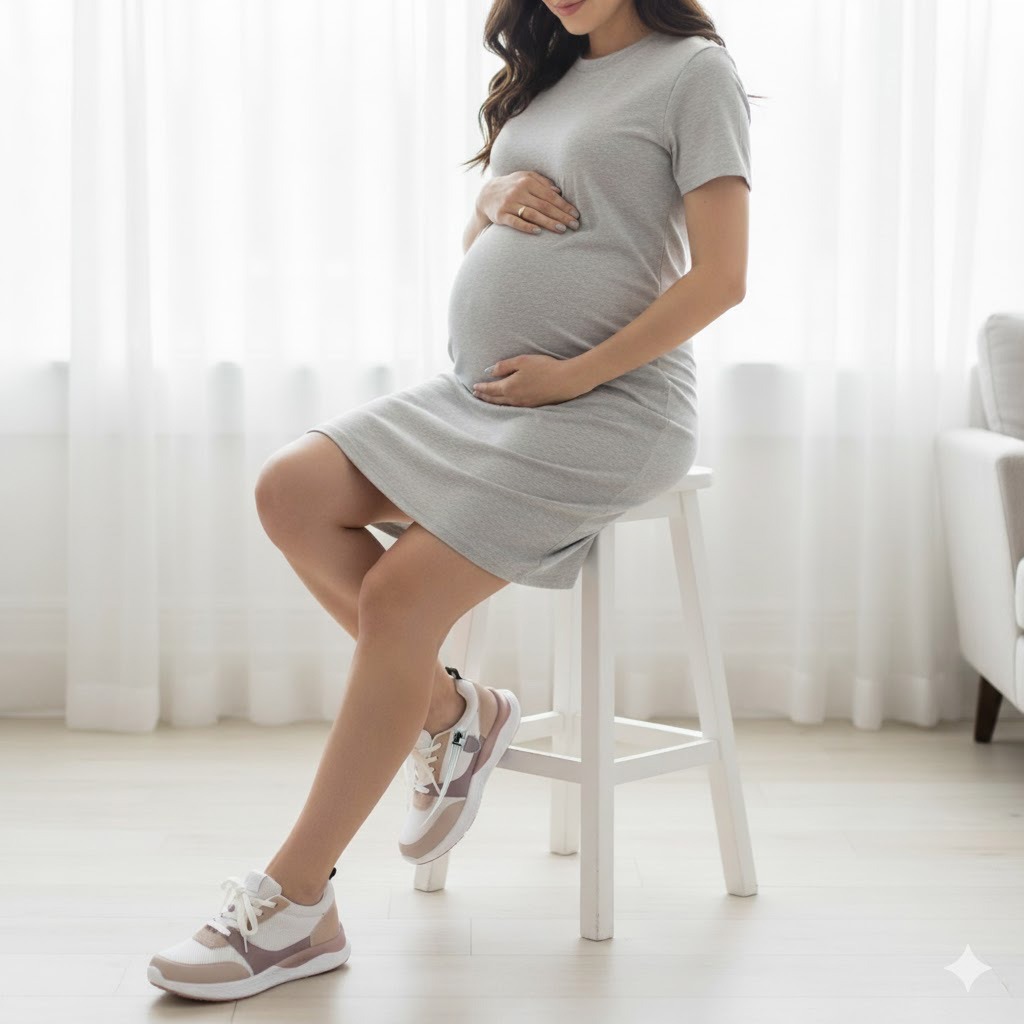Best Shoes for Pregnancy: The Complete Comfort Guide for Every Trimester
Your feet are working overtime during pregnancy. Between carrying extra weight, dealing with hormonal changes, and navigating shifting balance, your feet face challenges they’ve never encountered before. If you’ve noticed your favorite shoes feeling tight or your arches aching by midday, you’re not alone.
Research shows that approximately 80% of pregnant women experience lower extremity edema (foot and ankle swelling). Add hormonal changes that loosen ligaments, and you have a recipe for foot discomfort that can make every step feel like a challenge.
The good news? The right footwear can make an enormous difference. This guide combines medical research with practical shoe recommendations to help you find comfortable, supportive footwear for every stage of your pregnancy journey. Whether you’re in your first trimester or counting down to delivery day, you’ll discover how to keep your feet comfortable, supported, and ready to carry you through this incredible time.
Why Your Feet Change During Pregnancy
Understanding what’s happening to your feet during pregnancy helps you make smarter footwear choices. Let’s look at the science behind these changes.
The Science Behind Pregnancy Foot Swelling (Edema)
Foot swelling during pregnancy isn’t just uncomfortable-it’s incredibly common. According to research published in PubMed, lower extremity edema affects about 80% of all pregnancies, particularly in the third trimester.
Here’s why it happens:
Increased blood volume: Your body produces 50% more blood and fluids during pregnancy to support your growing baby. This extra fluid can pool in your feet and ankles, especially as the day progresses.
Hormonal changes: Pregnancy hormones like relaxin don’t just prepare your pelvis for delivery-they also relax blood vessel walls, making it easier for fluid to leak into surrounding tissues.
Uterus pressure: As your baby grows, your expanding uterus puts pressure on the veins that return blood from your legs to your heart, slowing circulation and causing fluid accumulation.
Most women notice swelling beginning in the second trimester, with the most significant changes occurring in the final weeks of pregnancy.
Overpronation and Arch Flattening
Beyond swelling, pregnancy causes another significant change: your feet actually flatten out. According to research from the University of Michigan Medicine, weight gain during pregnancy causes feet to lengthen and flatten, with some women finding their feet permanently wider and longer after giving birth.
This condition, called overpronation, occurs when your arches collapse inward as they bear extra weight. Overpronation can lead to:
- Heel pain (plantar fasciitis)
- Arch discomfort
- Ball-of-foot pain (metatarsalgia)
- Knee and hip strain from misalignment
These changes aren’t just temporary discomfort-studies show that many women experience permanent foot size increases of up to a half size after pregnancy. This makes choosing supportive, adaptable footwear even more critical.
What to Look for in Pregnancy Shoes
Not all comfortable shoes are pregnancy-friendly. Here are the essential features that make footwear work for your changing body.
5 Essential Features
1. Wide Toe Box
Your toes need room to spread naturally, especially when swelling strikes. Shoes with a wide, spacious toe box prevent pinching and allow for fluctuating foot width throughout the day. Look for shoes specifically designed with extra width or stretchy materials that accommodate changes.
2. Adjustable Closures
As your belly grows, bending over to tie laces becomes increasingly difficult. More importantly, adjustable closures like zippers, hook-and-loop straps, or elastic laces let you customize the fit as swelling comes and goes. Front or side zippers are particularly helpful since they don’t require bending at all.
3. Arch Support
Combat overpronation with shoes that offer built-in arch support or room for custom orthotics. According to orthopedic footwear experts at Aetrex, proper arch support helps align your feet, ankles, and knees, reducing pain throughout your body. Look for medial rearfoot posting and contoured footbeds.
4. Cushioning and Shock Absorption
Your feet hit the ground with more force during pregnancy due to extra weight. Memory foam insoles, EVA midsoles, or gel cushioning help absorb impact and reduce stress on your joints. This becomes especially important if you’re on your feet frequently.
5. Slip-Resistant Soles
Your center of gravity shifts during pregnancy, affecting balance. Shoes with textured, non-slip rubber outsoles provide crucial traction and stability, helping prevent falls-one of the most serious risks during pregnancy.
What to Avoid
While shopping for pregnancy shoes, steer clear of:
High heels: Your shifting center of gravity makes heels dangerous. They also increase pressure on the ball of your foot and can worsen back pain. If you must wear heels for an event, limit heel height to 1-2 inches and keep wear time minimal.
Completely flat shoes: Ballet flats and flip-flops might seem comfortable, but they offer zero arch support. This can worsen overpronation and lead to plantar fasciitis. Your feet need structure and support, not just softness.
Rigid materials: Stiff leather or synthetic uppers can’t accommodate swelling. Choose shoes with flexible, breathable materials that move with your feet rather than against them.
Best Pregnancy Shoes by Trimester
Your footwear needs evolve throughout pregnancy. Here’s what to prioritize during each stage.
First Trimester (Weeks 1-12)
During early pregnancy, you might not notice major foot changes yet. However, this is the perfect time to transition to supportive footwear before discomfort begins.
Focus on: Building your pregnancy shoe wardrobe with styles that offer arch support and room to grow. Measure your feet now to establish a baseline-you’ll likely need to remeasure in coming months.
Best styles: Supportive sneakers with good arch support, low-profile boots with cushioning, comfortable flats with built-in support.
Second Trimester (Weeks 13-27)
Swelling typically begins during the second trimester, and your balance starts to shift as your belly grows.
Focus on: Shoes with adjustable features and wider toe boxes. This is when you might need to size up by a half size. Avoid purchasing multiple pairs in the same size since your feet may continue changing.
Best styles: Slip-on sneakers with elastic laces, adjustable sandals with straps, shoes with zipper closures.
Third Trimester (Weeks 28-40)
Maximum swelling and difficulty bending make this the most challenging time for footwear.
Focus on: Easy-access shoes that require zero bending. Prioritize extreme comfort over style-your feet will thank you. Consider shoes that are a full size up from your pre-pregnancy size.
Best styles: Slip-on shoes with stretchy uppers, shoes with front zippers, cushioned slides for indoor wear.
Our Top Picks: Pregnancy-Friendly Shoes from Friendly Shoes
After understanding what your feet need during pregnancy, here are three excellent options from Friendly Shoes that check all the boxes for comfort, support, and easy access.
Best Overall: Excursion Wide Women’s Shoe

When it comes to pregnancy-friendly footwear, the Excursion Wide is purpose-built for the challenges you’re facing. This shoe was designed to “solve more types of footwear challenges,” and pregnancy definitely qualifies.
Key Features for Pregnancy:
- Extra-wide toe box: Explicitly designed to accommodate swelling without compression
- Stretchy upper material: Adapts to your foot’s changing dimensions throughout the day
- Memory foam insole: Provides cushioning that molds to your unique foot shape
- Rear zipper with front laces: Adjust the fit without bending over
- Multiple colorways: Find a style that works with your wardrobe
Best for: Women experiencing moderate to severe foot swelling who need reliable all-day comfort. The wide fit makes this ideal for second and third trimester wear.
Why it works: The combination of stretch fabric and adjustable closures means you won’t outgrow these shoes as swelling fluctuates. One customer described the “stretchy quality” as game-changing for accommodating swollen feet.
Best Easy Access: Voyage Women’s Shoe

If bending over has become a challenge, the Voyage makes getting shoes on and off completely effortless.
Key Features for Pregnancy:
- Front zipper access: Slip your foot in and zip up-no bending required
- Flexible fabric construction: Moves with your feet rather than restricting them
- Cushioned support: Soft footbed reduces pressure on sensitive areas
- Lightweight design: Doesn’t add extra weight to already tired feet
Best for: Mid to late pregnancy when mobility becomes limited. Perfect for women who need to get out the door quickly without assistance.
Why it works: The front zipper is a simple feature that makes a massive difference. You can put these on while sitting down without any awkward bending or reaching. The flexible construction also means they’ll accommodate changing foot dimensions throughout your pregnancy.
Other Pregnancy Friendly Shoes We Like

Orthofeet Women’s Orthopedic Knit Kita Hands-Free Sneakers

Allbirds Women’s Wool Lounger, Everyday Slip-On Sneakers
Expert Tips for Managing Pregnancy Foot Discomfort
Beyond choosing the right shoes, these strategies can help minimize foot pain and swelling:
Measure your feet regularly. Your shoe size can change throughout pregnancy, so measure every month or whenever shoes start feeling tight. Do this in the afternoon or evening when swelling is at its peak.
Consider pregnancy-specific insoles. Products like MommySteps maternity insoles or custom orthotics from Foot Levelers are designed specifically for pregnancy-related foot changes. They provide targeted arch support to combat overpronation.
Elevate your feet when possible. Whenever you’re sitting or lying down, prop your feet up above heart level. This helps fluid drain from your lower extremities and reduces swelling.
Wear compression socks. Medical-grade compression stockings have been shown in studies to reduce leg symptoms and edema during pregnancy. Put them on first thing in the morning before swelling begins.
Stay hydrated. It might seem counterintuitive, but drinking plenty of water actually helps reduce swelling. When you’re dehydrated, your body holds onto fluids more aggressively.
Walk regularly. Movement helps circulation and prevents fluid from pooling. Short, frequent walks in supportive shoes are better than long periods of standing or sitting.
Common Questions About Pregnancy Shoes (FAQ)
When should I size up my shoes during pregnancy?
Size up when your current shoes feel tight, leave marks on your feet, or cause discomfort. Most women need to size up by a half to full size during the second trimester. Don’t wait until your shoes are painful-prevention is easier than treating foot problems.
Will my feet return to normal after pregnancy?
Swelling typically resolves within a few weeks postpartum. However, research shows that many women experience permanent foot changes, including a half-size increase in length and wider feet. The ligament relaxation caused by pregnancy hormones can permanently alter foot structure.
Can I wear heels at all during pregnancy?
Podiatrists generally recommend avoiding heels above 2 inches during pregnancy due to balance and back strain concerns. If you must wear heels for special occasions, choose chunky, stable heels rather than stilettos, and limit wear time. Always pack comfortable backup shoes.
Are orthotic insoles safe during pregnancy?
Yes, orthotics are generally safe and can be beneficial during pregnancy. Custom orthotics specifically designed for pregnancy, like those from Foot Levelers’ Mother Nurture line, provide support tailored to pregnancy-related foot changes. Consult your healthcare provider if you have specific concerns.
What shoes are best for postpartum recovery?
Continue wearing supportive, comfortable shoes during postpartum recovery. While swelling typically decreases, your feet may remain sensitive, and you’ll be on your feet more with a newborn. Slip-on shoes remain ideal since you’ll frequently be carrying your baby. Give your feet 3-6 months before investing in new “permanent” footwear, as foot size may continue changing.
Conclusion
Finding the right shoes during pregnancy isn’t about sacrificing style – it’s about supporting your body through an incredible transformation. Motion is medicine, and good shoes are crucial to staying comfortable and active throughout your pregnancy journey.
Key takeaways:
- Choose shoes with a wide toe box, adjustable closures, arch support, cushioning, and slip-resistant soles
- Size up as needed-most women need a half to full size larger by the third trimester
- Prioritize easy-access features like zippers and slip-on designs as bending becomes difficult
- Consider pregnancy-specific orthotics for additional arch support
- Remember that foot changes may be permanent, so wait a few months postpartum before investing in expensive footwear
Your feet carry you through pregnancy and will carry you through the incredible adventure of parenthood that follows. Treat them well with footwear that supports, comforts, and adapts to your changing needs.
Ready to give your feet the comfort they deserve? Shop our pregnancy-friendly collection at Friendly Shoes and discover shoes designed to make every step easier and better.







